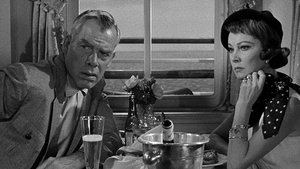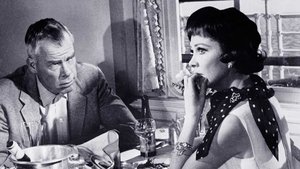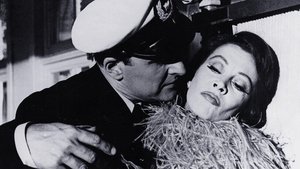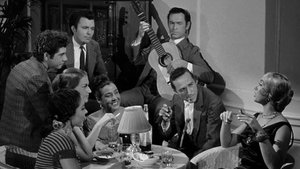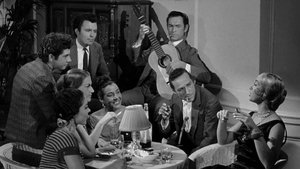Contact: info@alwanfilm.com
Video Sources 0 Views
- Watch trailer
- Ship of Fools 1965 Colorized

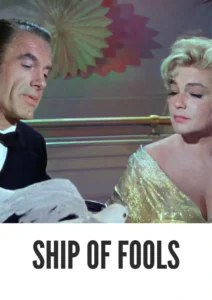
Synopsis
Table of Contents
ToggleShip of Fools 1965 Colorized Review: A Voyage Through Human Complexity and Social Struggles

Introduction
In 1965, acclaimed director Stanley Kramer took audiences on an extraordinary cinematic journey with Ship of Fools. Adapted from Katherine Anne Porter’s 1962 novel, this searing drama explores the intricacies of human nature aboard a German ocean liner set sail from Mexico to Europe in 1933, just as the world teeters on the brink of World War II. Ship of Fools (1965) remains a remarkable study of human behavior, where societal issues such as class struggle, bigotry, and lost love are laid bare against the claustrophobic backdrop of a ship’s confined spaces. The film’s early experiment with color further enhances the emotions conveyed, adding depth to the characters and their personal stories. In this review, we will explore the lasting significance of Ship of Fools, its ensemble cast, and how its colorized format alters the emotional weight of its narrative.
Check The Full Colorized Movies List
Check Our Colorized Movies Trailer Channel
Understanding Ship of Fools 1965 Colorized: Director, Cast, and Genre
Director’s Vision
Stanley Kramer, renowned for his socially conscious films, brought his unique touch to Ship of Fools. Kramer’s directorial style often revolved around moralistic storytelling, tackling weighty themes such as racial prejudice, political corruption, and the human condition. With Ship of Fools, he embraced the complexity of human emotions, showing how personal and political conflicts collide in intimate spaces. The ocean liner serves as a microcosm of 1930s society, and Kramer meticulously directs the interaction between characters, allowing the tensions between them to escalate as the journey progresses.
Kramer’s direction is masterful, particularly in his ability to balance multiple narratives. Each character’s arc is given ample room to breathe, resulting in a deeply immersive experience. His decision to maintain the slow, deliberate pace of the film mirrors the passengers’ gradual unraveling and emotional disintegration, leading to profound realizations by the film’s conclusion.
The Stellar Ensemble Cast
Ship of Fools boasts one of the most impressive ensemble casts in cinema history. At the heart of the film is Vivien Leigh, who delivers a powerful performance in what would become her final film role. Leigh plays the role of Mary Treadwell, a faded beauty desperately clinging to her past glories and grappling with her own disillusionment. Her portrayal of a woman in decline is heartbreaking, showing the toll of lost love and the struggle to find meaning in an increasingly superficial world.
Oskar Werner shines as Dr. Schumann, a German ship’s doctor suffering from a terminal illness, whose relationship with La Condesa (played by Simone Signoret), a Spanish countess on her way to a political prison, adds a tragic romantic subplot to the film. Werner’s restrained performance is both tender and melancholic, capturing the internal conflict of a man torn between duty and passion.
Other notable performances include Lee Marvin as Bill Tenny, an aging, alcoholic baseball player, and José Ferrer as Siegfried Rieber, a brash and unapologetically bigoted German businessman. The interactions between these diverse characters serve as the emotional engine of the film, highlighting their individual flaws and societal prejudices.
Exploring the Genre
Ship of Fools (1965) falls into the genre of drama, though it also borders on political allegory and psychological exploration. Unlike other films of its era, which often leaned heavily into melodrama or romanticized storytelling, Ship of Fools offers a stark, unsentimental look at humanity’s darker impulses. The film’s themes of moral failure, social inequality, and existential despair are timeless, making it resonate with audiences both in its day and today. The ocean liner setting also aligns it with the subgenre of “confined space dramas,” where the pressure cooker environment heightens the characters’ emotional journeys.
Exploring the World of Ship of Fools 1965 Colorized: Plot and Characters
Detailed Synopsis
The plot of Ship of Fools is set aboard a German ocean liner, transporting a diverse group of passengers from Mexico to Europe in 1933. The world is on the cusp of political upheaval, with Nazism rising in Germany and other totalitarian regimes taking hold across Europe. Onboard the ship, passengers from different walks of life are forced into close quarters, and their personal struggles and prejudices come to the forefront.
The narrative doesn’t revolve around a single protagonist but rather presents a mosaic of interconnected stories. At the center of these stories is the doomed romance between Dr. Schumann (Oskar Werner) and La Condesa (Simone Signoret), whose illicit love affair is complicated by Schumann’s terminal illness and La Condesa’s impending political imprisonment.
Meanwhile, Vivien Leigh’s character, Mary Treadwell, represents the themes of loneliness and regret. Her interactions with other passengers, including a brief affair with a much younger man, reveal the desperation she feels as she struggles to come to terms with aging and a life of missed opportunities.
Bill Tenny (Lee Marvin), a former athlete, embodies the decline of American ideals, representing the fallout of those who once epitomized success but are now broken by their own flaws. Siegfried Rieber (José Ferrer) offers a chilling portrayal of casual anti-Semitism, reflecting the rising tide of fascism in Europe.
Each character’s journey on the ship mirrors the larger societal issues of the time, making Ship of Fools a powerful allegory for the human condition in a world on the verge of chaos.
The Art of Film Colorization
Understanding the Process
Film colorization is a process that adds color to black-and-white films, often using digital techniques to apply color frame by frame. In the 1960s, colorization was a developing technology, and Ship of Fools, originally shot in black and white, was later released in a colorized version to appeal to modern audiences. This decision has sparked debate, as colorization can dramatically alter the mood and tone of a film.
In Ship of Fools, the original black-and-white cinematography was carefully chosen to underscore the film’s themes of existential despair and societal decay. The use of monochrome reflected the moral greyness of the characters and the era. However, the colorized version adds a new layer to the film, enhancing certain visual elements such as the costumes, the lush settings of the ocean liner, and the vibrancy of the sea.
Development Over Time
The development of colorization technology has evolved from hand-painted frames to sophisticated digital processes. Early colorized films often appeared unnatural, with skin tones and lighting mismatches that detracted from the viewing experience. However, as the technology has improved, colorized versions of classic films now offer a more seamless visual experience. While Ship of Fools was not initially intended for color, its modernized version gives viewers the option to experience the film in a different visual format.
Early Colored Films: A Brief History
Emergence of Early Colored Techniques
The journey toward color film began long before Ship of Fools. Early filmmakers experimented with various techniques, including hand-tinting, in which individual frames were painted by hand to add color. Processes like two-strip Technicolor also emerged in the 1920s and 1930s, offering a limited color palette that eventually evolved into the three-strip Technicolor process, which brought vibrant, full-color films like Gone with the Wind (1939) and The Wizard of Oz (1939) to life.
Though color was used in some early films, black-and-white cinematography remained the dominant format for many decades due to its cost-effectiveness and its artistic capacity to convey mood and texture.
Ship of Fools 1965 and Its Early Colored Version
The Decision to Release in Color
The decision to release a colorized version of Ship of Fools was a bold one, given the film’s original use of black and white to evoke a sense of moral ambiguity and emotional intensity. By adding color to the film, the creators aimed to make the film more accessible to modern audiences who might be more accustomed to full-color features. The colorized version enhances certain visual elements, such as the costumes and the luxurious interiors of the ocean liner, while still preserving the gravity of the film’s narrative.
Impact on the Visual Narrative
The colorized version of Ship of Fools offers a different viewing experience, with colors adding a layer of realism to the film’s world. The vibrant hues of the ocean and the ship’s interiors contrast sharply with the characters’ bleak emotional journeys, emphasizing the disconnect between their external surroundings and internal struggles. However, for some viewers, the original black-and-white format may still be preferable, as it aligns with the film’s overarching themes of moral decay and the impending darkness of World War II.
The Debate Over Film Colorization
Controversy Surrounding Colorization
The colorization of black-and-white films has been a contentious issue for decades. Purists argue that films shot in black and white were designed to be experienced that way, and colorization can compromise the filmmakers’ original artistic vision. This is particularly relevant for films like Ship of Fools, where the black-and-white cinematography was carefully crafted to convey mood and tone.
On the other hand, proponents of colorization argue that it can introduce classic films to new generations of viewers who may be more drawn to color features. Colorization can also highlight details that might be lost in monochrome, such as the intricacies of costume design and set decoration.
Examining Ship of Fools 1965 as an Early Colored Film
Enhancement or Distraction?
For Ship of Fools, the question remains whether colorization enhances or distracts from the film’s narrative and emotional impact. The colorized version certainly brings a new visual layer to the film, making the lush setting of the ocean liner more tangible. The costumes, particularly the elegant dresses worn by Vivien Leigh’s character, gain added richness in color.
However, the original black-and-white version has its own strengths, particularly in the way it conveys the emotional desolation of the characters. The stark contrast between light and shadow in black and white underscores the moral complexity of the film, allowing viewers to focus more intently on the characters’ internal struggles rather than the external setting.
Influence and Legacy: Ship of Fools 1965 Colorized’s Impact on Cinema
Cultural and Historical Influence
Ship of Fools (1965) stands as one of the great ensemble dramas of its time, influencing the way filmmakers approach stories with multiple characters and complex themes. It paved the way for future films that examine society through the lens of individual relationships, including works like Grand Hotel (1932) and Robert Altman’s Nashville (1975), both of which employ a similar narrative structure.
Stanley Kramer’s focus on social issues, particularly bigotry and human folly, has left a lasting impact on cinema. His use of a confined space to explore these themes in Ship of Fools has been emulated in later films, where the setting acts as a pressure cooker for human conflict.
Director’s Cinematic Legacy: Beyond Ship of Fools 1965 Colorized
Kramer’s Influence on Filmmaking
Stanley Kramer’s legacy extends beyond Ship of Fools, as his body of work consistently challenged audiences to confront social and moral dilemmas. His films, such as Judgment at Nuremberg (1961) and Guess Who’s Coming to Dinner (1967), tackled issues of race, justice, and human rights long before they became central to mainstream cinema. Kramer’s fearless approach to controversial topics set a precedent for future filmmakers, cementing his place as one of the most influential directors of his time.
Themes Explored in Ship of Fools 1965 Colorized
Darkness, Despair, and Social Decay
The themes of Ship of Fools revolve around darkness, both external and internal. As the passengers journey towards Europe, they are also heading towards personal ruin, and the film explores how societal decay mirrors individual moral failings. Themes of class struggle, racism, and existential despair are central to the narrative, as each character is forced to confront their own demons.
The political backdrop of the film, with Nazism on the rise, adds to the sense of impending doom. Characters like Siegfried Rieber represent the growing tide of fascism, while others, like La Condesa and Dr. Schumann, are caught in the crossfire of political and personal turmoil.
Reception and Controversy Surrounding Ship of Fools 1965 Colorized
Initial Reviews and Audience Reactions
Upon its release, Ship of Fools received widespread acclaim for its thought-provoking narrative and strong performances. Critics praised Stanley Kramer for his direction, particularly in managing the film’s ensemble cast. Vivien Leigh and Oskar Werner were singled out for their standout performances, with Werner receiving an Academy Award nomination for Best Actor.
However, like many of Kramer’s films, Ship of Fools also sparked controversy due to its heavy themes and unflinching portrayal of societal issues. Some critics felt the film was too didactic, while others found it emotionally draining. The later colorized version also received mixed reactions, with some viewers appreciating the added visual depth and others preferring the starkness of the original black and white.
Where to Watch Ship of Fools 1965 Colorized Online
For modern audiences looking to experience Ship of Fools, the film is available on several streaming platforms, including Amazon Prime Video and Criterion Channel. Both the original black-and-white version and the colorized edition are accessible, allowing viewers to choose their preferred version. Additionally, DVD and Blu-ray versions of the film can be purchased, often featuring restored colorized versions along with the original cut.
FAQs About Ship of Fools 1965 Colorized
Q: What makes Ship of Fools (1965) significant in film history?
A: Ship of Fools is significant for its exploration of complex human emotions and its portrayal of societal issues. Directed by Stanley Kramer, the film addresses themes of bigotry, class struggle, and existential despair against the backdrop of pre-World War II Europe.
Q: Who stars in Ship of Fools (1965)?
A: The film stars Vivien Leigh, Oskar Werner, Simone Signoret, Lee Marvin, and José Ferrer, among others.
Q: Was Ship of Fools (1965) shot in color?
A: No, the film was originally shot in black and white, but a colorized version was later released.
Q: What themes are explored in the film?
A: The film explores themes of darkness, social decay, class struggles, racism, and the personal toll of moral failure.
Conclusion
Ship of Fools (1965) remains a powerful testament to Stanley Kramer’s mastery of socially conscious filmmaking. With its stellar ensemble cast, rich thematic depth, and intense emotional exploration, the film offers a stark look at the human condition in a world on the cusp of war. Whether experienced in its original black-and-white form or in the colorized version, Ship of Fools continues to resonate with audiences today, reminding us of the timelessness of its themes and the ongoing relevance of its social commentary. As Kramer’s cinematic legacy endures, so too does the haunting voyage of Ship of Fools, a film that stands as both a warning and a reflection of human folly.
